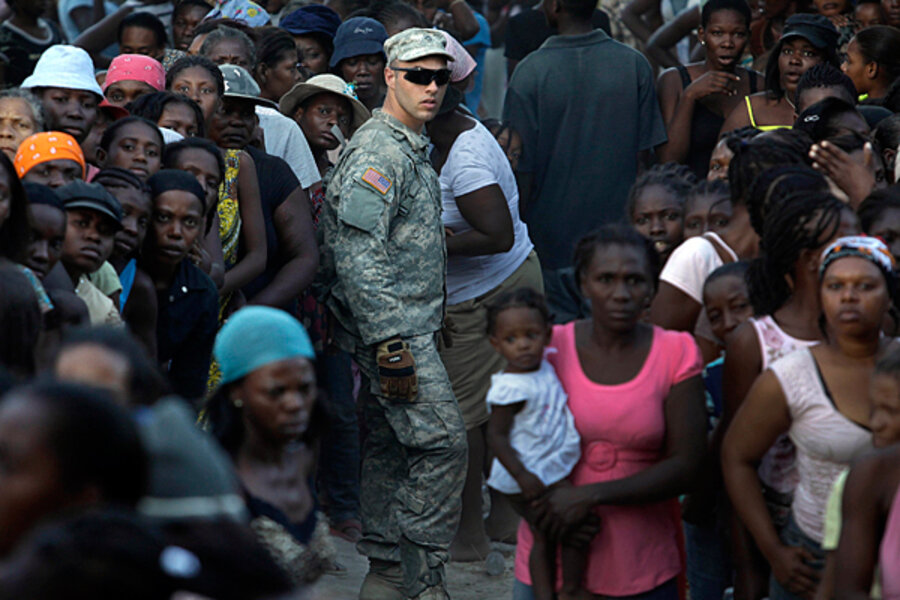At Haiti golf course, 82nd Airborne runs a refugee camp
Loading...
| Port-au-Prince, Haiti
It was once a thing of beauty for Haiti’s elite – a rolling nine-hole golf course, overlooking Port-au-Prince and the ocean beyond and framed by Hispaniola's central mountain range.
Today it’s a patchwork of blankets, sheets, tarps and cardboard, sheltering as many as 50,000 displaced people.
At first, the draw for the displaced was the open space. “We’re here because we have no homes or our homes are unsafe,” said Louissaint Bannichton, a painter, who has constructed a cardboard dwelling for himself and family and friends, which he jokingly calls “the National Palace.”
After the earthquake felled a wall along the lower part of the course, far from the clubhouse, residents of the hard-hit Delmas neighborhood poured into the unusual expanse of grass and set up camp.
Meanwhile, the US military was also looking for space – but one for landing helicopters. They narrowed in on the upper course, by the elegant, stone clubhouse and pool. “It’s a nice neighborhood,” said Captain John Hartsock, pointing out the US Ambassador’s residence next door, “but that’s not why we came here. We’re here because of the big green space out there.”
The U.S. military didn’t talk to the club’s owner, Coty Reinbold, until after Hartsock landed on the grass. The club’s private security guards were present, which “made things interesting,” Hartsock said, but they let him stay and eventually bring more than 300 troops from his 82nd Airborne Division’s First Squadron 73rd Cavalry Regiment, from Fort Bragg, North Carolina. Reingold said he doesn’t like speaking with journalists, but Hartsock reported that the club owner has been “bending over backwards” to help make the operation work.
The troops, who sleep on the tennis courts, have been distributing roughly 10,000 water bottles and 4,000 meals a day and are running a medical clinic. The food and water have been supplied by USAID and Catholic Relief Services.
The crowd at the camp is swelling, as more of the displaced hear about the distributions.
“Right now I’m on average pushing through about 50 Haitians every minute, at a minimum getting them a bottle of water,” Hartsock said.
Fight for water
To many in the camp, that’s not enough. After distributions, crowds left empty-handed, disappointed, hungry and thirsty.
“We’re here for the food and water,” said Laurent Natel, a camp resident, watching with friends as the military and local volunteers gave handouts to a females-only line. “But it’s not easy to do. The day before yesterday we got it, but today there are too many people and too much fighting. First they give only to the girls, and then it’s the boys’ turn, but it’s too much for me. I stay out of the line because I cannot fight.”
When the men were called to come forward, the line formed in a frantic rush, leaving behind those unwilling or unable to push.
Residents throughout the camp complained that the food should be brought to them, tent by tent. While 10,000 water bottles might seem like a lot, that might be one bottle for every five people, in an entire day, in a sweltering camp. There remains a long line when the supplies run out.
Meanwhile, up at the clubhouse, representatives of the Army and CRS seemed to be somewhere close to the same page, meeting Wednesday afternoon to discuss a better way to get the food out, and to tour the camp in search of potential distribution sites.
"What they're trying to do now is organize the camp," said Lane Hartill, a CRS information officer, "to partition it into quadrants so it's more manageable to coordinate food delivery."
CRS has been bringing food kits, water, and tarps in from a warehouse in the Dominican Republic, and groups have been searching Port-au-Prince for other good food distribution sites. But it's hard to beat the golf course.
"Obviously, security is a concern. That's why the Petionville Club was so great." The club's guards are on post at the front gate, and US troops escort visitors into the club. Refugee families have no trouble entering the course directly, over the fallen wall, but troops stand guard on the edge of the camp and around the roped-in food distribution lines.
Those in the club on the hill and those on the lower holes are also on the same page about another point: they have no idea how long they will be here. “As long as it takes to help the people of Haiti recover from this thing,” Hartsock said. “We’ll be here ‘til they say go.”
Down in the camp, residents say they can’t imagine leaving any time soon, and many are working to make their home better, helping with distributions, forming volunteer clean-up crews, playing musical instruments and singing, and holding morning prayer. Some children play soccer with a small rubber ball, while others enjoy the never-before-seen contours of a golf course, sliding down its smooth slopes on makeshift cardboard sleds.





